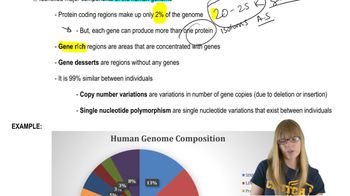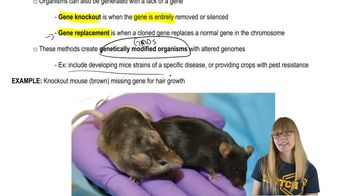Table of contents
- 1. Introduction to Genetics51m
- 2. Mendel's Laws of Inheritance3h 37m
- 3. Extensions to Mendelian Inheritance2h 41m
- 4. Genetic Mapping and Linkage2h 28m
- 5. Genetics of Bacteria and Viruses1h 21m
- 6. Chromosomal Variation1h 48m
- 7. DNA and Chromosome Structure56m
- 8. DNA Replication1h 10m
- 9. Mitosis and Meiosis1h 34m
- 10. Transcription1h 0m
- 11. Translation58m
- 12. Gene Regulation in Prokaryotes1h 19m
- 13. Gene Regulation in Eukaryotes44m
- 14. Genetic Control of Development44m
- 15. Genomes and Genomics1h 50m
- 16. Transposable Elements47m
- 17. Mutation, Repair, and Recombination1h 6m
- 18. Molecular Genetic Tools19m
- 19. Cancer Genetics29m
- 20. Quantitative Genetics1h 26m
- 21. Population Genetics50m
- 22. Evolutionary Genetics29m
15. Genomes and Genomics
Genomics and Human Medicine
Problem 8
Textbook Question
Describe how CRISPR–Cas has been modified to create a genome-editing tool.
 Verified step by step guidance
Verified step by step guidance1
CRISPR-Cas9 is a naturally occurring defense mechanism found in bacteria, which they use to protect themselves from viral infections by cutting the DNA of the invading virus.
Scientists have harnessed this system for genome editing by modifying the Cas9 protein to be guided by a synthetic RNA molecule, known as guide RNA (gRNA), which can be designed to target specific DNA sequences in the genome.
The guide RNA binds to the Cas9 protein and directs it to the specific location in the genome where a cut is desired. This is achieved by designing the gRNA to be complementary to the target DNA sequence.
Once the Cas9 protein is guided to the target site by the gRNA, it creates a double-strand break in the DNA. This break can then be repaired by the cell's natural repair mechanisms, which can be harnessed to introduce specific changes or edits to the DNA sequence.
Researchers can use this system to knock out genes, insert new genetic material, or make precise changes to the DNA sequence, making CRISPR-Cas9 a powerful tool for genetic engineering and research.
Recommended similar problem, with video answer:
 Verified Solution
Verified SolutionThis video solution was recommended by our tutors as helpful for the problem above
Video duration:
3mPlay a video:
Was this helpful?
Key Concepts
Here are the essential concepts you must grasp in order to answer the question correctly.
CRISPR-Cas System
The CRISPR-Cas system is a natural defense mechanism found in bacteria that protects against viral infections. It consists of CRISPR sequences, which store segments of viral DNA, and Cas proteins that can cut DNA. This system has been harnessed for genome editing, allowing precise modifications to DNA in various organisms.
Recommended video:
Guided course

Genomic Variation
Genome Editing
Genome editing refers to the techniques used to alter the genetic material of an organism. CRISPR-Cas9 is one of the most prominent methods, enabling targeted changes to DNA sequences. This technology has applications in medicine, agriculture, and research, facilitating the study of gene function and the development of genetically modified organisms.
Recommended video:
Guided course

Genomics Overview
Modifications of CRISPR-Cas
Modifications to the CRISPR-Cas system have enhanced its specificity and efficiency for genome editing. These include engineering Cas proteins to improve their targeting accuracy, developing new delivery methods for CRISPR components, and creating variations like CRISPR-Cas12 and Cas13, which can target RNA. Such advancements expand the potential applications of CRISPR technology in various fields.
Recommended video:
Guided course

Post Translational Modifications

 6:51m
6:51mWatch next
Master Human Genome Composition with a bite sized video explanation from Kylia Goodner
Start learningRelated Videos
Related Practice



